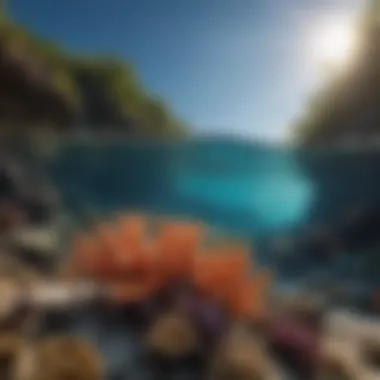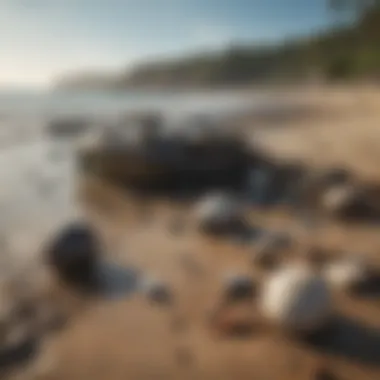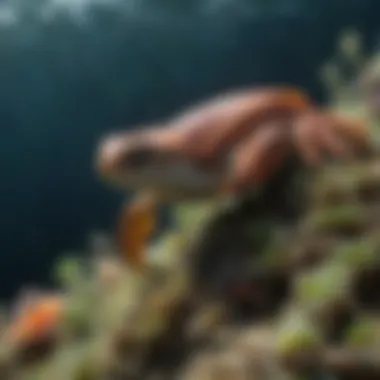Exploring Marine Environmental Issues: A Comprehensive Overview


Intro
The ocean and our waterways are essential not only for marine life but also for human recreation and enjoyment. As watersports enthusiasts, it is critical to understand the marine environmental issues that affect these precious ecosystems. Engaging in activities like surfing, snorkeling, sailing, and paddleboarding comes with the responsibility of mitigating our impact on the environment. Awareness of topics such as pollution, climate change, and overfishing is necessary to protect our aquatic playgrounds. This article implores watersports enthusiasts to delve into these issues, fostering conservation efforts and sustainable practices vital for the health of our oceans.
Water Activity Overview
Surfing offers a connection with the ocean. Recognized for its exhilarating waves, surfing requires appreciation for and respect of nature. However, it faces challenges such as waste from mass tourism and popular surf spots.
Sailing is another engaging activity that blends relaxation with adventure. Whether cruising on calm waters or challenging the open sea, sailors must navigate the delicate balance of human activity and marine health.
Snorkeling provides a window into the underwater realm. While it allows participants to witness ocean biodiversity firsthand, increased participation can lead to awareness of reef damages and pollution.
Paddleboarding, known for its limited environmental impact, promotes environmental appreciation. Yet, as its popularity increases, so do potential threats to coastal habitats.
Knowing these activities enriches the understanding of marine ecosystems and the essentials of their preservation.
Tips and Techniques
Converting your passion for water sports into eco-friendly practices can be simpler than expected.
- Tips for beginners
Start with awareness of the surrounding ecosystem. Using reef-friendly sunscreen can greatly reduce damage to coral. Learn to paddle or surf responsibly without harming sea life. - Advanced techniques for experienced enthusiasts
Get involved in conservation efforts by participating in beach cleanups or advocating for sustainable practices in localized communities. Advanced surfers may explore lesser-known areas to promote lesser pressure on major spots. - Safety guidelines
Always prioritize your safety by ensuring proper training and equipment usage. Proper maintenance of gear increases its lifespan and reduces disposal of broken items.
Gear Reviews
With the multitude of gear options available, analysis is important to stay informed and support sustainable production. The following equipments merit a closer look:
- Surfboards
Consider brands known for eco-friendly materials, such as Firewire Surfboards, which utilize recycled materials in their boards. - Sailboats
Opt for designs that enhance efficiency, such as those produced by Dufour Yachts, as they can reduce fossil fuel consumption. - Snorkeling equipment
Purchase snorkels and masks from manufacturers like Aqua Lung, which prioritize sustainable practices in production. - Paddleboards
Brands like BOTE are known for their commitment to quality and environmentally conscious materials. - Wetsuits
Evaluate options from O’Neill which offers a line made from Eco-Friendly materials, thus minimizing vape dangers.
Destination Guides


Voyaging to locate ideal watersport terrain holds numerous opportunities to experience natural beauty while participating in activities:
- Popular water sports locations
Destinations like Hawaii and the Great Barrier Reef are favored. Their pristine conditions offer both challenges and aesthetic pleasure. - Hidden gems for water enthusiasts
Places such as coastlines in Nicaragua provide untouched visuals. They can enhance beautify experiences with their tranquility. - Travel tips for water sports trips
Taking public transport or eco-taxis promotes a responsible trip while mitigating the carbon footprint.
Engaging in marine activities should come with the understanding and preparedness to protect marine spaces.
Every surf, paddle, and sail contributes to an ecosystem that is in danger. Our activity in this realm must carry responsibility, leading to thoughtful environmental stewardship that preserves these bodies of water for future enjoyment.
Intro to Marine Environmental Issues
Marine environmental issues are crucial to understand. They impact not only marine ecosystems but also human communities and economies that depend on oceans and waterways. The ocean is a delicate balance between various elements, and disturbance in this balance can lead to significant consequences. This article highlights various aspects of these marine concerns in an effort to raise awareness and promote sustainable interactions with our waters.
Definition and Scope
Marine environmental issues encompass a range of challenges faced by oceans and their ecosystems. These include pollution from plastics, chemicals, and other waste, climate change effects such as temperature rise and acidification, overfishing which depletes fish populations, and habitat destruction affecting species biodiversity. Their scope ranges from local waters to global oceans, affecting both developed and developing coastal regions. The urgency of addressing these matters increases as they contribute to the degradation of marine biodiversity and ecosystem health.
Relevance to Watersports Enthusiasts
For individuals who engage in watersports, the relevance of marine environmental issues cannot be overlooked. Enthusiasts typically seek out pristine waters and healthy ecosystems, which are now under threat. Ensuring the wellbeing of marine environments is vital for preserving the experiences he holds dear. As each person involved in these activities contributes to the pressures faced by the oceans, awareness is essential.
By understanding these environmental challenges, watersports enthusiasts can become advocates for positive change. Whether they choose to support conservation initiatives or even modify their own behaviors to reduce harmful impacts, each action counts. Greater knowledge leads to more responsible practices in oceans and waterways, ultimately sustaining the joy and beauty of watersport activities.
"Every drop in the ocean counts.
This principle aligns closely with the attitudes that guided past conservation efforts and underscores the importance of collective action."
Continuous education and involvement in community efforts can promote a deep respect for marine environments and their protection. The intersection of personal passion with Eco-consciousness can inspire a constructive movement toward healthier oceans.
Pollution and Its Effects


Pollution, in its numerous forms, poses one of the gravest threats to marine ecosystems. These contaminants seep into every facet of marine life, introducing both visible and hidden dangers. Addressing this subject is imperative. Increased awareness can lead to more focused conservation efforts among watersports enthusiasts and other stakeholders. Understanding pollution allows individuals to make informed decisions and adopt environmentally-friendly practices.
Types of Marine Pollution
Plastic Pollution
Plastic pollution has emerged as a major challenge. It refers to the accumulation of plastic products in the oceans, adversely affecting wildlife and marine habitats. A distinctive feature of plastic pollution is its durability. Unlike organic materials, plastics can persist in the environment for hundreds of years. This characteristic raises concerns about long-term ecological impacts. Addressing this issue is vital for the sustainable use of our oceans.
The harm caused by plastics is significant. Marine animals, mistaking plastic items for food, ingest them, leading to poisoning and often death. As shared in a report by the United Nations, it is estimated that over 800 species worldwide are affected by marine debris, particularly plastics. The reality is stark, emphasizing the urgency of combating plastic pollution—not only for the preservation of marine species but also for maintaining healthy, functional ecosystems.
Chemical Pollution
Chemical pollution involves the release of harmful substances into marine environments. It encompasses a wide range of pollutants, including pesticides, heavy metals, and pharmaceuticals. One key characteristic of chemical pollution is its potential for bioaccumulation. This means that these toxic substances can build up in the bodies of marine creatures over time, exempting them from immediate harm while posing serious threats to both marine and human health in the long run.
Chemical pollution is particularly insidious, often not immediately visible. Its presence can lead to chronic health issues in marine populations, which might eventually disrupt fishing communities that rely on these ecosystems for their livelihoods. As a result, examining this topic is crucial for developing strategies that minimize such harmful impacts.
Oil Spills
Oil spills represent significant environmental disasters. They occur when petroleum or oil accidentally entered the ocean, typically during transportation via tankers or rigs. The spread of oil not only creates a visual disaster but also severely disrupts marine environments. Oil spills coat marine life and habitats in thick, toxic layers. This sticky substance impairs insulation for seals, relaxes feathers for birds, and ultimately leads to loss of life.
One unique feature of oil spills is their persistent capacity to harm marine environments over extended periods. Impacts of oil gripping to the shoreline can last for decades, affecting growth patterns, reproductive rates, and general health of various species. Spills raise complicated questions and attract greater scrutiny over maritime safety regulations, enhancing their relevance to this article's objectives.
Impact on Marine Life
Effects on Species
The effects of pollution on species are catastrophic. Marine organisms struggle to thrive in contaminated environments due to weakened ecosystems. Many species suffer population declines driven by both direct impacts, such as poisoning, and indirect effects from habitat degradation. It becomes a grim cycle, where diminishment of one species spirals down through the entire ecosystem. Thus, it hints at the far-reaching consequences of our pollution-driven endeavors.
Watersports enthusiasts often value diverse and vibrant marine ecosystems. However, with declining populations, experiences in the water change. Encountering less wildlife translates to diminished enjoyment of these activities. Recognizing the intertwined fate of marine life and recreational activities can lead to responsible stewardship.


Food Chain Disruption
Food chain disruption poses threats to an entire ecological network. Pollution causes alterations in species health and behavior. Weakened predator-prey relationships contribute to instability in marine ecosystems. Some toxic substances alter reproductive behaviors or growth patterns. As smaller fish consume plastic or chemicals, they place their predators at risk through contamination.
For those engaged in watersports, understanding the food chain's integrity emphasizes a need for caution. Maintaining a balanced marine ecosystem is vital for conserving biodiversity and safeguarding the quality of experiences on the water. Ignoring pollution's long-reaching effects could jeopardize the fascinating encounters that make watersports appealing.
In summary, pollution represents a formidable threat to marine environments. Its multidimensional impacts are profound—spanning from visible destruction to the subtle shifts affecting the food web. Watersports enthusiasts have the opportunity to play an active role in conservathing these crucial aquatic ecosystems through education and awareness.
Climate Change and the Ocean
Climate change significantly impacts the ocean, influencing not just ecological balance but also human activities such as watersports. By understanding its consequences, enthusiasts can better engage in conservation efforts. One critical area to consider is ocean temperature rise. Without awareness and action, the overall health of marine environments could deteriorate, affecting much more than the beauty of ocean waters.
Ocean Temperature Rise
The rise in ocean temperatures is often a direct consequence of increasing global temperatures. Warmer waters lead to various alarming effects. Firstly, numerous marine species rely on specific temperature ranges for reproduction and survival. When temperatures exceed natural thresholds, species like coral suffer, exhibiting stress responses that lead to bleaching. This disrupts entire ecosystems, as many fish depend on coral reefs for habitat and food.
Studies show that in many ocean regions, temperatures have risen significantly. For example, research indicated an increase of nearly 2 degrees Celsius in certain areas within the last few decades. Upward water temperature has also impacted currents and ecosystems extensively, presenting significant concern for both marine life and human activities related to watersports.
Acidification of Oceans
As the ocean absorbs excess carbon dioxide from the atmosphere, the chemical composition of seawater changes, leading to ocean acidification. This process endangers key marine species such as shellfish and corals that rely on calcium carbonate to develop their shells and structures.
Reduced pH levels hinder the development of these organisms, impacting entire food webs. Additionally, acidic conditions disrupt swimming patterns and physiological processes for many fish species. These changes result in alterations to fish populations, which can indirectly affect recreational fisheries and subsequently, tourism activities linked to onto-the-water practices.
The importance of mitigating acidification cannot be underestimated. Educating communities about eco-friendly practices and drawing attention to aligned ocean policies is vital to combat ocean acidification effectively.
Sea Level Rise and Its Impacts
Sea level rise remains one of the most visible effects of climate change. As glaciers and polar ice caps melt due to rising temperatures, the volume of freshwater increases significantly, impacting coastal regions. This rise presents a significant threat to shoreline ecosystems, which are critical for both marine life and human communities.
Low-lying areas often face flooding, which leads to habitat destruction. In coastal regions, this encroachment diminishes the available living space for many species, altering predator and prey relations. As significant portions of inhabited areas increasingly become submerged, standard living arrangements and local economies faced disruptions. This change has implications for the watersports community; fewer accessible beach areas may curtail activities and negatively affect tourism and associated businesses that rely on those waterfronts.
Key Impacts of Sea Level Rise:
- Loss of habitat for wildlife.
- Increased flooding risk for coastal communities.
- Elevation of storm surges, leading to severe weather damage.
- Potential disruption to marine tourism activities.















